Spelling Rules: Which Rules to Teach + Free Printables
This post may contain affiliate links. As an Amazon affiliate, we earn from qualifying purchases. See our disclosure policy.
Learn the basics about spelling rules in English! As a bonus, we include links to lots of freebies to help teach and reinforce the specific spelling rules you’re working on. Read, learn, and grab your free printables!

Why Teach Spelling Rules?
Research rooted in the Science of Reading says that systemic, explicit instruction is necessary for kids to learn to read and spell. All children should be explicitly taught spelling for various reasons:
- More than 50% of words in English follow normal and predictable spelling patterns.
- Denise Eide, in her book Uncovering the Logic of English, explains that learning phonograms and spelling “rules help to explain 98% of English words.”
- Louisa Moats, in her 2005 article, found that spelling instruction supports reading because of how closely the two are tied together.
- D. Reed (2012) presents multiple studies confirming that when reading and spelling instruction were both taught, it “led to significant gains in phonemic awareness, alphabetic decoding, word reading, spelling, fluency, and comprehension.”
✨ This means that we can make sense of spelling, it’s beneficial, and it should be explicitly taught!
Yes, there will always be exceptions to some rules because of the complexity of the history of the English language, and that’s okay.
However, explicitly teaching phonics, spelling rules, and conventions will allow kids to:
- Recognize patterns and systems in our language
- Make connections between words
- Become proficient readers and spellers
- Build important skills like phonological awareness, decoding, fluency, and comprehension.
And that’s what it’s all about!
What Are The Spelling Rules?
Below we will outline some common spelling rules that all students should learn:
- Cat/Kite
- Never a Q Without a U
- FLOSS
- K vs. CK
- Gentle Cindy
- Y as a Vowel
- Long Spelling
- Every Syllable Must Have a Vowel
- English Spelling Rules
- Schwa
- Suffix Rules
Instruction in spelling can begin with the basics as early as kindergarten and should continue each year, progressing to more complex concepts. If you’re not sure where to start, give your students a spelling inventory to assess their current spelling and encoding skills.
Cat/Kite Rule
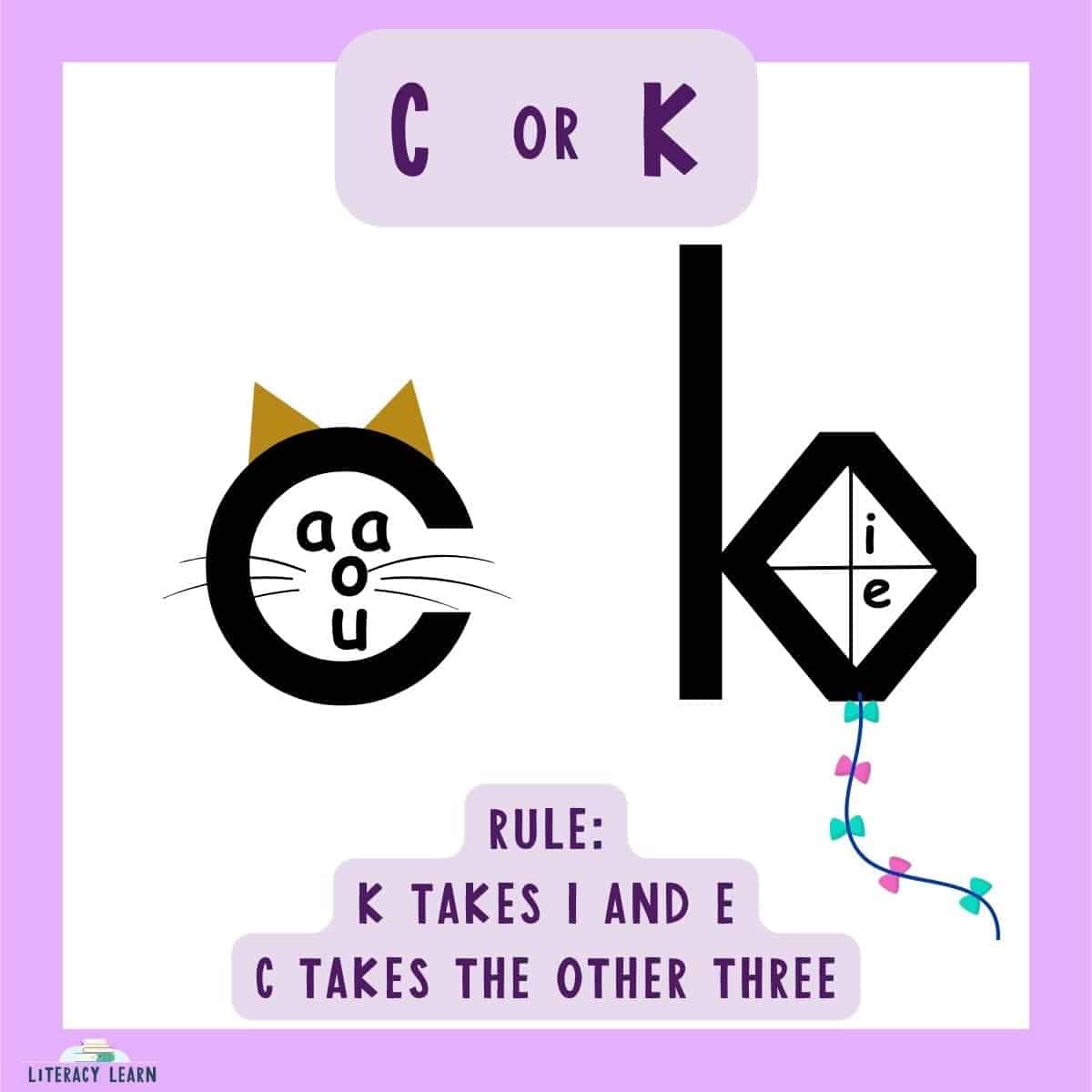
This rule is for words that start with the /k/ sound. How do you know to spell the word with a C or K?
- Use K when the vowels i and e follow the /k/ sound (kite, Ken).
- Use C when letters a, o, u, and other consonants follow the /k/ sound (cat, cop, cup, crib).
👉 Free Resource: Get a free C vs. K anchor chart & practice worksheet! 🐈🪁
Never a Q Without a U
The letter Q will always have the letter U next to it. As a result, you should teach the letters qu together, starting in pre-k and kindergarten.
Note: The letter U is not considered a vowel here since it doesn’t make any vowel sound.
👉 Free Resources: Get 13 FREE QU worksheets for your students to practice! 👑
Floss Rule
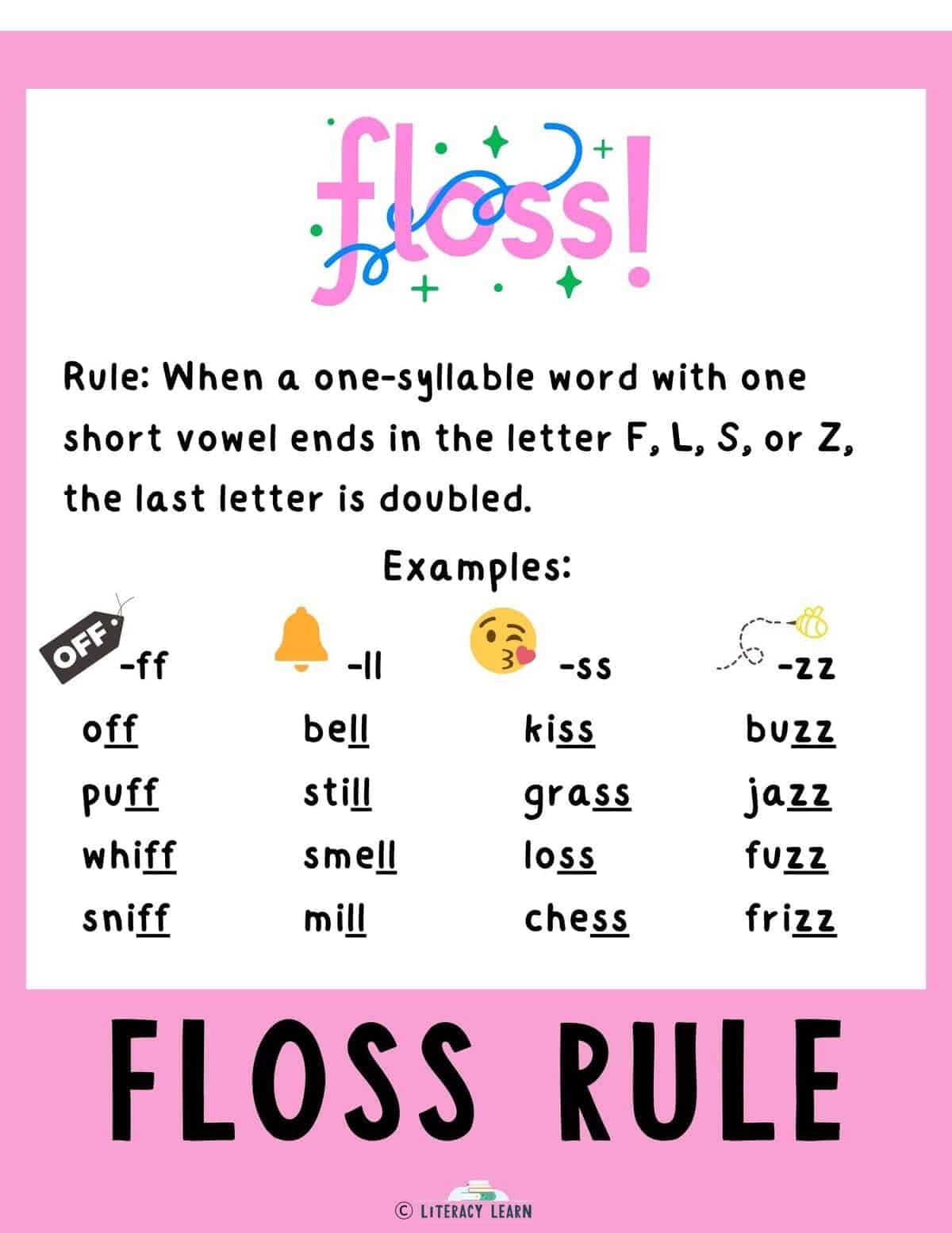
This spelling rule is applied to one-syllable words, with one short vowel, that end in the letters f, l, s, or z. The last letter is doubled like in the words fluff, fill, moss, and buzz.
👉 Free Resources: Learn more about the Floss Rule and get a free anchor chart and floss word list! 🦷
K vs. CK Rule
When you hear a /k/ sound at the end of a one-syllable word, you will spell it …
- -ck after a short vowel (back)
- -k after a long vowel (bake)
- -k after a consonant (bark)
- -k after two vowels (seek)
Gentle Cindy Rule
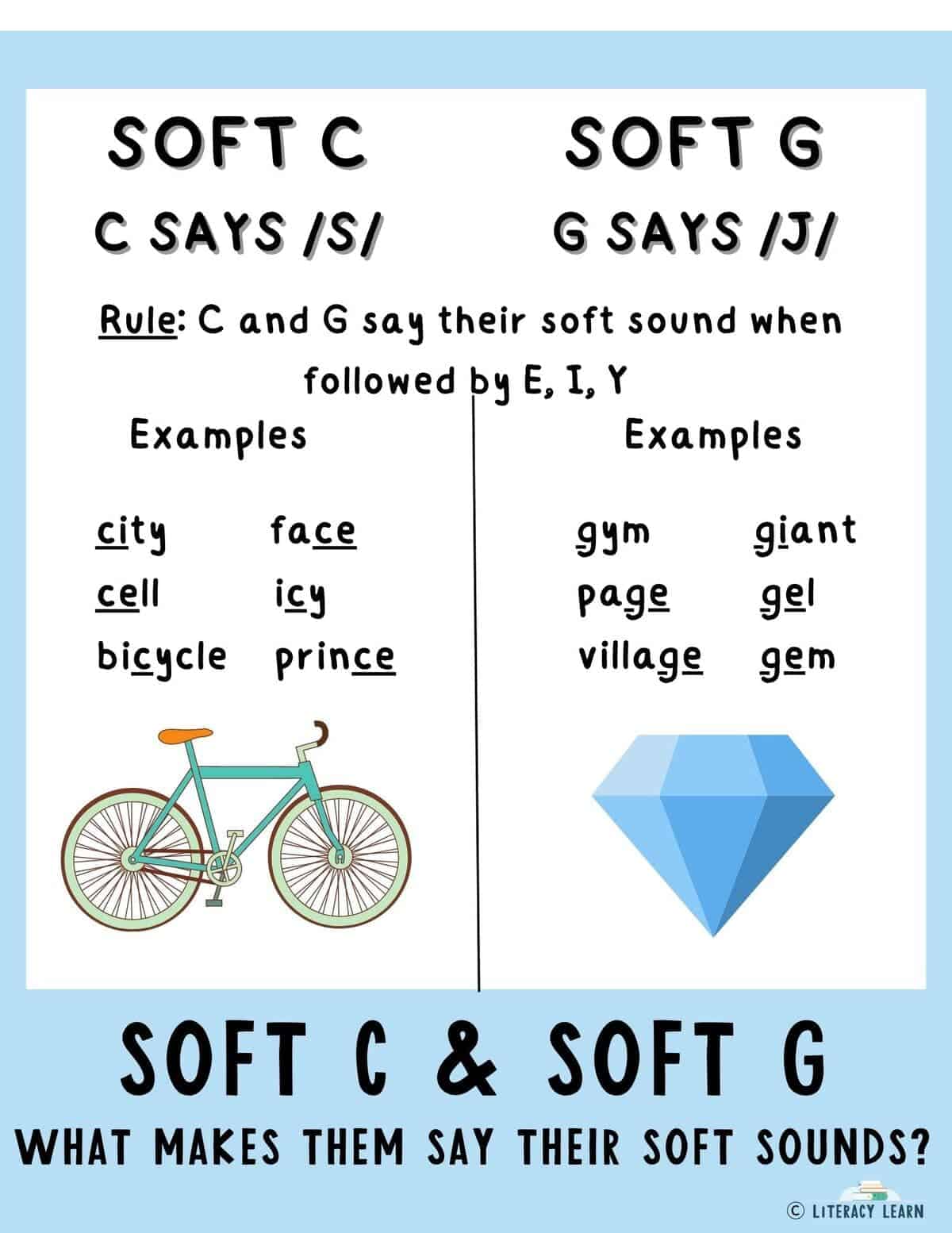
The letters C and G will say their soft sound when followed by an E, I, or Y.
- C says /s/ when it is followed by an E, I, or Y (face, city, cycle)
- G says /j/ when it is followed by an E, I, or Y (gem, ginger, gym)
👉 Free Resources: Learn more about Soft C and Soft G, and get a free Gentle Cindy anchor chart!
Y as a Vowel
Y is used as a vowel in more than 70% of words. So let’s stop saying the vowel jingle as “A, E, I, O, U and sometimes y.” Instead, let’s start saying: “A, E, I, O, U and Y, most of the time.“ 🎶
- Y says long i at the end of one syllable words (cry, by).
- Y says long e only at the end of 2+ syllable words (baby, happy).
- Y says short /ĭ/ in the middle of a word or in a closed syllable (gym, myth, cylinder). These words are usually of Greek origin.
Long Spelling

Use the longer-spelled phonograms in one-syllable words after a short vowel.
- -ck for the /k/ sound (duck)
- -dge for the /j/ sound (fudge)
- -tch for the /ch/ sound (witch)
🎶 I teach my students to pound this jingle: “Long spelling right after a short vowel.”
Every Syllable MUST Have a Vowel
For more on syllables and the six syllable types, get extensive syllable division resources, and check out tons of free resources for:
- Closed Syllables
- Open Syllables
- Magic e Syllables
- R-controlled Syllables
- Diphthong/Vowel team Syllables
- Consonant-le Syllable
Then, grab our Syllable Types Bundle, complete with anchor charts, syllable division rules, & practice worksheets.
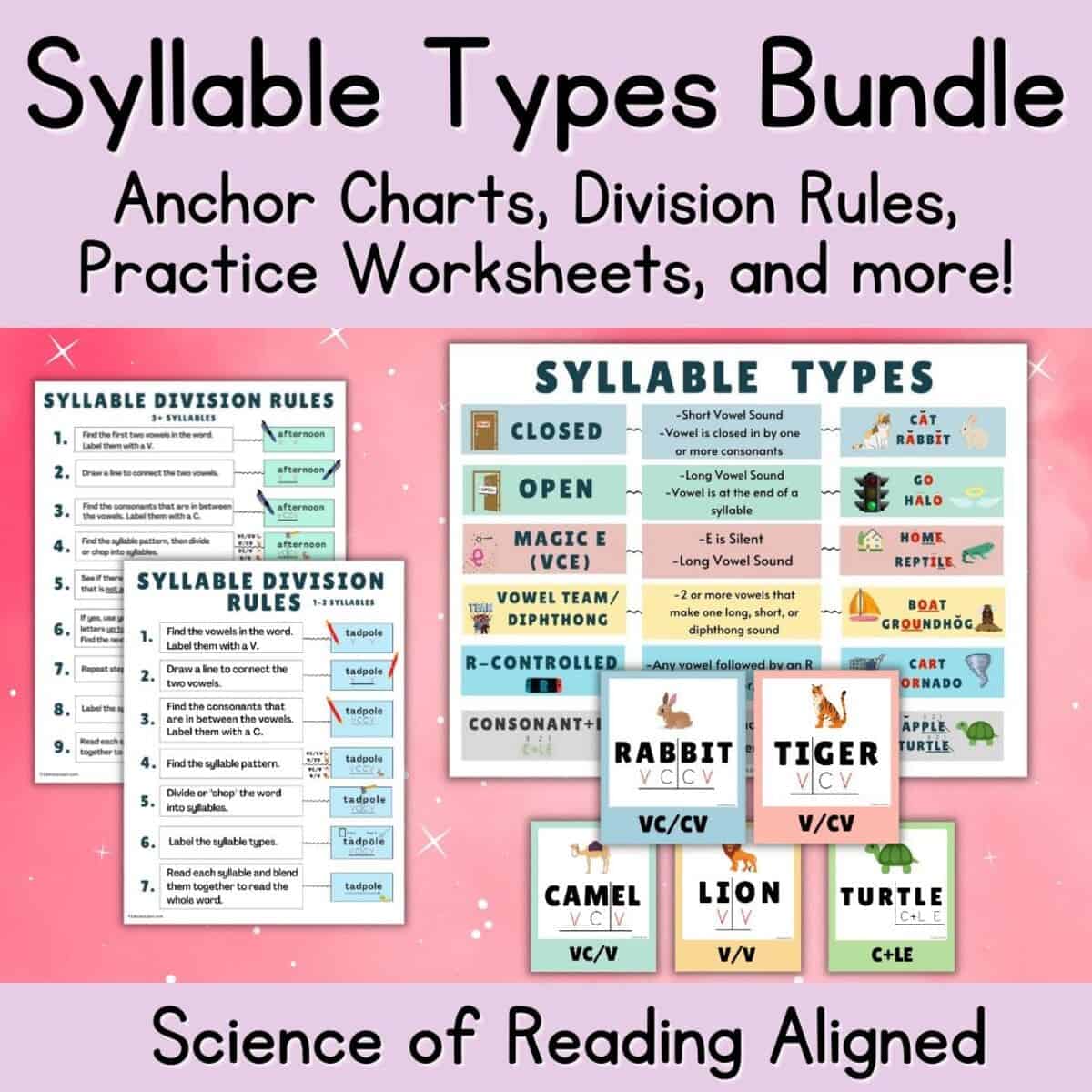
English Spelling Rules
English words never end in the letters I, U, V, or J.
- If you hear a /j/ sound at the end of a word, it is spelled -ge or -dge (huge/fudge).
- If you hear a /v/ sound at the end of the word, it will have a silent e after it. Words like have and give, are NOT magic E words. There are actually 9 jobs of silent e. This is one job.
- If a word ends with the letter i, it is not an English word.
✨ Pro tip: Use the online etymology dictionary to find word origins. It’s fascinating!
Schwa
In an unstressed syllable or word, all five vowels can say a schwa sound /ŭ/ or /ĭ/.
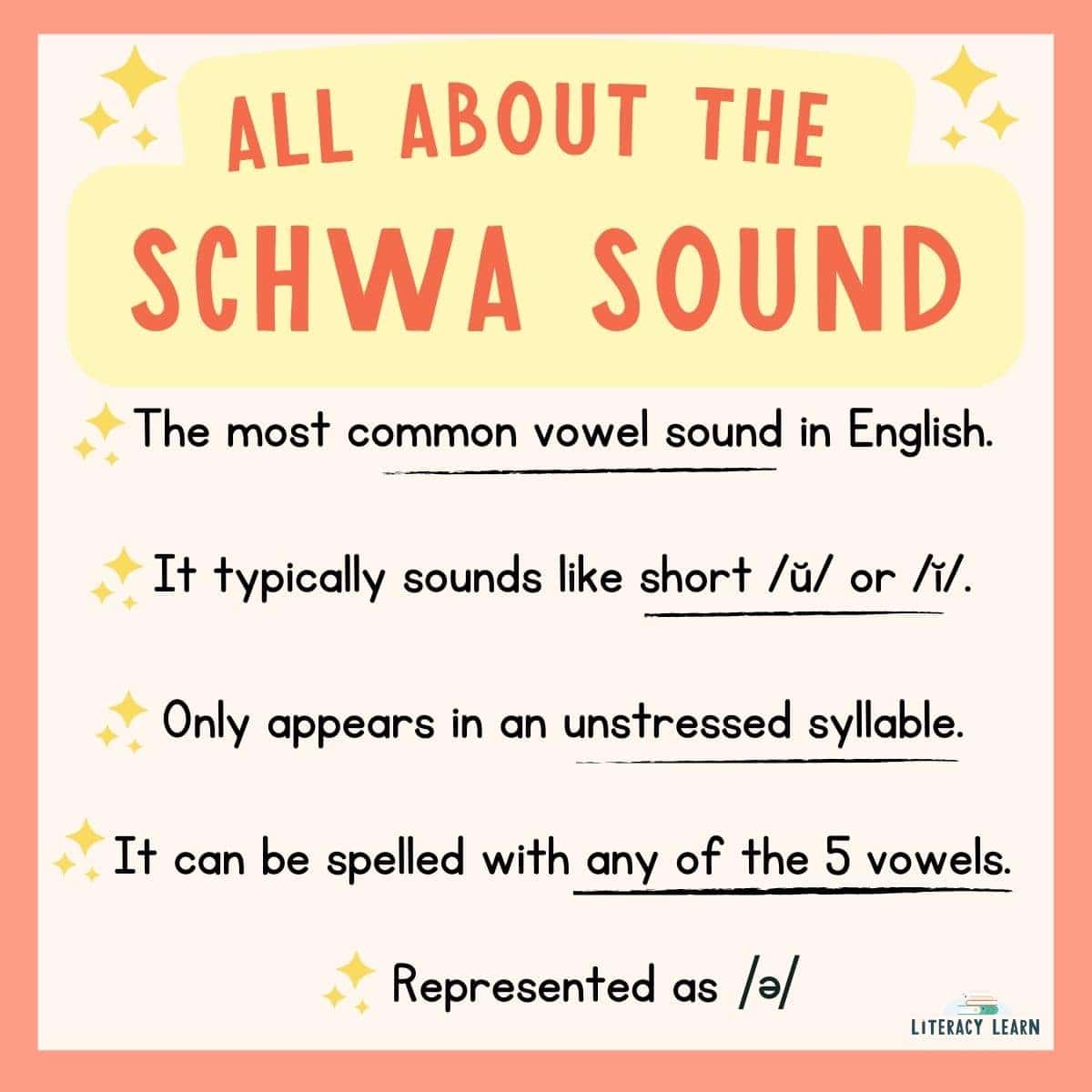
Did you know? The schwa is the most common vowel sound in the English language! This will be an important concept to teach!
👉 Free Resource: Get free printable Schwa Sound Word Lists for dictation practice and more!
Suffix Rules
There are 3 rules for suffixes: Doubling Rule, Drop Rule, and Change Rule.
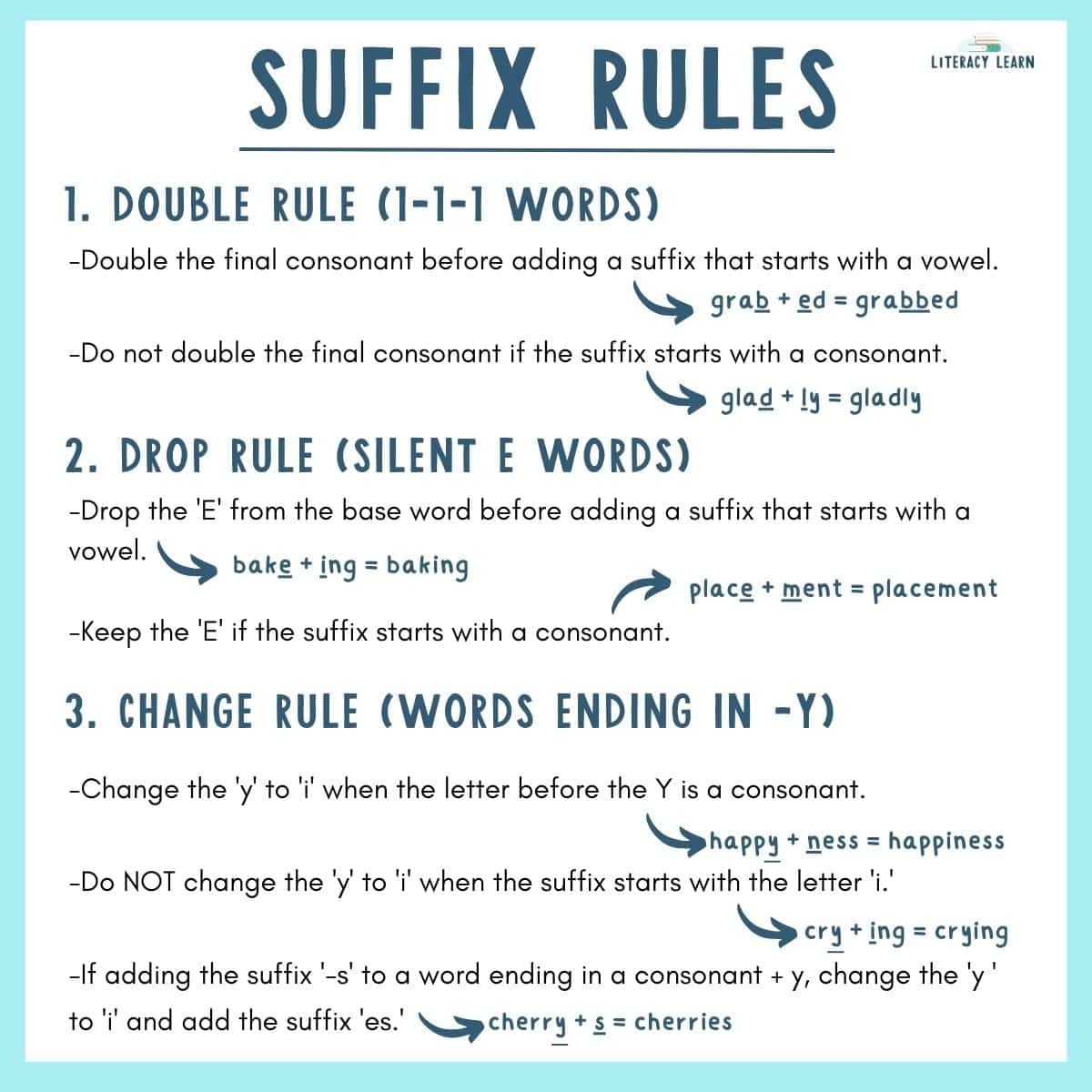
👉🏽 Doubling Rule: This rule pertains to 1 syllable words with 1 short vowel that end in 1 consonant (1-1-1 words).
- Double the final consonant before adding a suffix that starts with a vowel.
➡️ grab + ed = grabbed - Do not double the final consonant if the suffix starts with a consonant.
➡️ glad + ly = gladly
👉🏽 Drop Rule: This rule pertains to words that end in Silent E, or follow a VCe pattern.
- Drop the ‘E’ from the base word before adding a suffix that starts with a vowel.
➡️ bake + ing = baking - Keep the ‘E’ if the suffix starts with a consonant
➡️ place + ment = placement
👉🏽 Change Rule: This rule pertains to words that end with Y.
- Change the ‘y’ to ‘i’ when the letter before the Y is a consonant.
➡️ happy +ness = happiness - Do NOT change the ‘y’ to ‘i’ when the suffix starts with the letter ‘i.’
➡️ cry +ing = crying - If adding the suffix ‘-s’ to a word ending in a consonant+y, change the ‘y ‘ to ‘i’ and add suffix ‘es.’
➡️ cherry + s = cherries
What to Do With Rule Breakers
Because of the complexity of the English language (Anglo-Saxon, Latin, and Greek), we know there are some words that will always be rule-breakers. So what can we do to teach these rule-breakers to kids?
First, we should do our own digging to see if the spelling can be explained. Sometimes the reasons for spelling can turn into an interesting history lesson that can make language become exciting for children.
Here are a few examples of rule-breaker words (or so we think!):
- Bus: According to the floss rule, it should be spelled as ‘buss.’ However, this is a rule breaker because ‘bus’ is actually a shortened version of the word ‘autobus.’
- Broccoli: English words don’t end in ‘i,’ so why do we see it at the end of this word? It’s because its origin is Italian.
- Love/some/come: Why does the o say /u/ sound in these words? Teach students about the scribal o. In Old English, these words were spelled with the letter U. But the scribes didn’t like this because the U stokes looked too similar to the stroked of the letter following it, and people couldn’t read their writing. So the scribes changed the letter U to an O.
- What: This word has a part that can’t be decoded – the phoneme doesn’t match the grapheme. So we teach it as a heart word.
- Mileage: This is a true rule breaker, and we aren’t sure why! According to the ‘drop rule,’ the letter e should be dropped when adding the suffix -age since it starts with a vowel. This is just going to be an exception.
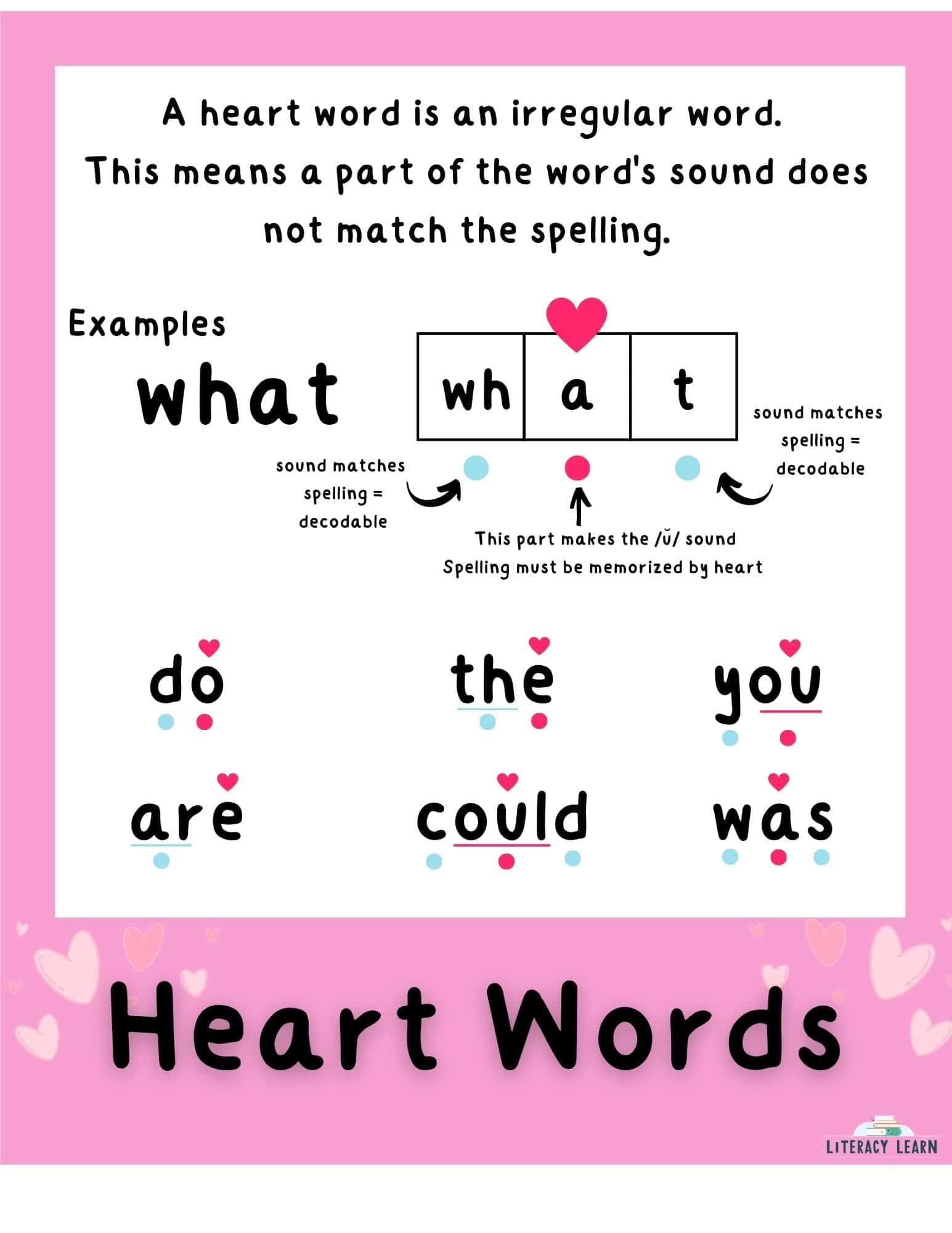
If there is no explanation, we explicitly teach the words as rule breakers. Teachers should provide opportunities for multimodal practice so kids can memorize the irregular spellings, or the irregular portions of the word. Some ideas include:
- Spelling the word aloud while writing it using Simultaneous Oral Spelling.
- Provide repeated practice in fun, engaging ways. Use our Spelling Practice Tic Tac Toe or Spell Out Loud board game.
- Section off a particular part of the phonics notebook to teach these irregular words. Kids can go back to them for review!
For tons of fun ideas, visit our post where we discuss authentic and multimodal ways to engage students in your OG literacy lessons.

Conclusion
Important Fact: The most well-known mnemonic spelling rule is “I before E, except after C.”
This is NOT a rule we want to teach, an analysis of over 350,000 common English words found that I comes before E, even after C in 75% of words. Let’s throw this rule out! 🗑
We hope you feel encouraged and equipped to teach your students about these spelling rules! These are all important parts of the English code, and necessary for children to understand to be successful readers, spellers, and writers!
References:
- Eide, D. (2011). Uncovering the logic of English. Logic of English.
- Moats, L. C. (2005/2006, winter). How spelling supports reading: And why it is more regular and predictable than you may think. American Educator, 29(4),12–22, 42–4
- Reed, D. K. (2012) Why teach spelling? Portsmouth, NH. RMC Research Corporation, Center on Instruction.
Related Resources
- All About Using Sound Walls in the Classroom
- 376+ Nonsense Words – 6 Free Lists
- 3 Sounds of Suffix -ED
- Phoneme-Grapheme Mapping Worksheets
- Science of Reading Morphology Poster
Do you have questions or comments? We’d love to hear your best ideas for teaching spelling rules or questions you still have. Please leave us a comment below.

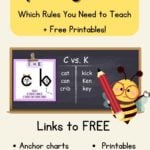
Hello!
Awesome materials – merci!
Where can I download ALL of your spelling rules/posters and worksheets in one place? (free or not)
Take care!
Karolyn
Hi Karolyn,
You can get a bunch of posters in our TPT store. Here is the link to 24 spelling rules posters.
Let us know if you need anything else 😉
Katie and Laura